
Behavioral Ecologist Charles Brown studies cliff swallows, which (like humans) live in many different types of colonies.
How many people live in the building where you live? What’s it like to live with that many people?
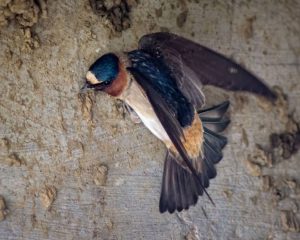
How did the cliff swallow cross the road? Read on to find out how Behavioral Ecologist Charles Brown discovered a way that many cliff swallows avoid being hit by cars.
Once upon a time, cliff swallows lived on … cliffs, where they built their nests under horizontal ledges. But these days, most of these birds (Petrochelidon pyrrhonota is the scientific name for the American cliff swallow) live under bridges and highway culverts and also on buildings. Like many other species of animals and plants, cliff swallows have found cool ways to share their habitats with human beings.
Do you live in a large city, surrounded by thousands of people? In a small town or suburb? Or out in the countryside, where you can’t see the homes of your closest neighbors? Like people, cliff swallows live in different types of groups. Many live in large colonies. Brown, a biology professor at the University of Tulsa, found 6000 nests under one bridge. That’s the largest one he has found. Cliff swallows’ smallest colonies range from single nests to about 100 nests. Intermediate colonies range from 100 to 500 nests. And large colonies contain more than 500 nests, built of mud and grass.

The typical sizes of cliff swallow colonies vary from year to year: why is that so? Brown has found that they change with the climate. In colder years, birds living in larger colonies survive better. Cliff swallows eat insects which travel in swarms. These swarms move from place to place, making it hard work for birds to figure out where to find their next meal. When it’s more difficult to find insects to eat, which is especially true during unusually cold seasons, having other swallows nesting nearby makes it easier to find food. A neighbor might arrive with insects to feed his or her babies, making it possible for a swallow to follow that bird back to the swarm. And during bad weather, a swallow that finds a swarm gives a special call, bringing other birds from its colony to share the feast and help track the insects’ movement.
In warmer years, on the other hand, birds in smaller colonies have better survival rates. They don’t need as much help from neighbors in order to find food. And there are so many insects and other creatures around in warm weather that blood-sucking parasites like swallow bugs (similar to bed bugs) attack the swallows, making it better to live in small groups to avoid the spread of disease.
At the age of six, Charles Brown collected feathers, taping each one onto a piece of paper and using a bird book to decide what species it came from. He asked his mother what you call someone who studies birds. When she taught him the word “ornithologist,” Charles declared, “That’s what I want to be when I grow up.”
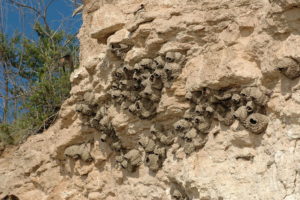
But he didn’t wait until becoming an adult. By the age of 11, Charles had become an expert on purple martins, the largest type of swallow. Most purple martins live in bird houses humans build for them. “They’re very tame birds and people like to have them around,” says Brown. Charles watched the martins outside his parents’ house, taking notes on what he saw. “I was doing basic biology on them, describing their behavior and reproductive success. When I became interested in them, I collected everything that had been written on purple martins.”
He read and read, and kept watching. Eventually, he realized that “there were things that I knew about martins that weren’t in the literature” and decided to share what he was learning in his own yard. The Auk, the journal of the American Ornithologists’ Union, doesn’t publish papers written by teenagers very often. But they took Charles’s work seriously: “The editor sent it to a reviewer, who basically rewrote the thing for me and they published it. I was 15 when it came out: my first scientific article.”
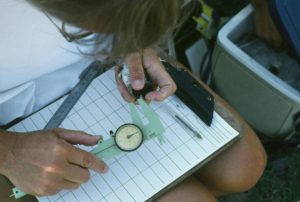
Brown kept watching birds and writing about them. He wrote to and then began meeting with Warren Pulich, the author of The Birds of North Central Texas. Pulich, who taught biology at the University of Dallas, led birdwatching trips near Sherman, where Charles grew up. Brown continued to write up his discoveries about martins during college and then read an article about bank swallows, written by Zoologist John Hoogland. They exchanged letters and Brown decided to study with Hoogland at Princeton University.
Hoogland inspired him to think about the sizes of groups animals form and some of their other behaviors. “I read a letter from John Hoogland with the suggestion [that Brown study cliff swallows, who live in colonies], thought about it for five minutes, and I’ve been working on them ever since.” The cliff swallow “has proven to be a fantastic animal: in western Nebraska, near the town of Ogallala, there are hundreds of different colonies of many sizes.” Brown travels there each year. He and his colleagues count the nests in swallow colonies and catch individual birds in mist nets. Working quickly and gently, they put bands on the legs of birds they have not caught before, use calipers to measure each bird’s beak and wing, and find each bird’s weight with a spring scale. They also try to figure out whether each bird is female or male. This is not easy to do: early in the year, females tend to be heavier, but most of the time “they look alike, they act the same, they’re the same size … [and] sometimes we have trouble determining whether an individual is a male or a female.”
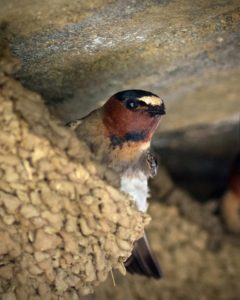
So, how did the cliff swallow cross the road? Since he first began studying these birds in 1982, Brown has noticed that some of them get hit by cars and die while flying across roads. Any time he sees a cliff swallow lying at the side of the road, he picks it up, preserves its body, and adds it to his collection: Brown is an amateur taxidermist. So when one of his field assistants asked him to teach her how preserve a bird after it had died, he said “we’ll find plenty of dead birds this summer and you can use those to practice.”
But they did not find any dead birds by the road in western Nebraska that summer. And when he thought about it a bit, Brown realized that “I’m not seeing the numbers of road kills that we used to see.” In the 1980s and ‘90s, “we would have bags of dead birds that we would find on the road each summer.” Brown went back over his collection of birds and the dates he had found them and noticed “this very steep decline in the numbers we were finding and saving, from 1982 to 2012.”
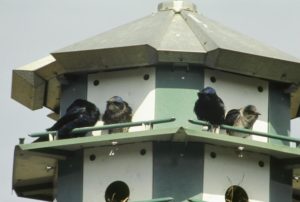
Why were fewer birds being killed by traffic? Had the researchers been traveling less? Had the cliff swallow population in Nebraska gone down? Or were there fewer cars and trucks on the road? Brown checked his own records and did additional research to find that the answer to each of these possible explanations was “No.” It became clear that “this is a real phenomenon: fewer birds are being killed by cars now” than they were 30 years ago.
So Brown and his colleagues turned to the birds themselves to discover why fewer of them are being killed on streets. They looked at those who had died accidentally in nets each year and compared them with the whole population they studied (mostly live birds) and with the birds found at the side of the road. “Those killed by cars had longer wings than the rest of the population. It looks like cars are exerting a selective pressure on cliff swallows.” Shorter wings allow birds to swerve away from an oncoming vehicle more quickly. And they also help them take off from the ground at a steeper angle, flying high into the air faster than a bird with longer wings can. “Natural selection can operate quickly,” says Brown, and traffic on the roads seems to have played a role in making cliff swallows develop shorter wings in the past few decades.

